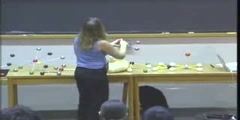Chemical Science - Transition Metals - Lecture 30
Principles of Chemical Science/nVideo Lectures - Lecture 30/nTopics covered: /nTransition Metals/nInstructor: /nProf. Catherine Drennan/nTranscript - Lecture 30/nYou all should have these handouts ready to go now./nLet's review where we were last week. If everyone can settle down a little bit, you can discuss about who wants to be the top chemistry major later on after class is over./nAll right. Octahedral case./nHere is our octahedral molecule. And, again, crystal field theory is just an explanation for the things that are observed experimentally. It is a fairly simple theory. And, if you go on to study chemistry, and you will take more inorganic chemistry later on, you will learn about more complicated theories./nBut this is really simple./nThis simple theory just thinks about each ligand, each small molecule like NH3 group bound to a metal. The metal is in the center position. That each ligand considers as a negative point charge. And so then the theory looks at whether that ligand, as a negative point charge, is pointing toward one of the d-orbitals./nYou need to know about the shapes of the d-orbitals./nAnd you need to know about the shapes of the coordination complexes. And then you need to just ask yourself, is that ligand pointing directly toward a d-orbital./nIf it is then it will be destabilized. If it is not then those orbitals will be stabilized. And so you are talking about the stabilization relative to an imaginary spherical and crystal field where ligands are just sort of everywhere all around the center metal./nYou consider that as sort of your standard case where all of the d-orbitals have the same energy./nBut then when you consider those ligands as negative point charges in particular locations, some d-orbitals then get destabilized and other ones get stabilized in terms of energy. In the octahedral case then, and here is our little cartoon for the octahedral case where there are ligands along the z-axis, ligands along the x-axis and ligands along the y-axis./nAnd so if you look at dx2 minus y2, you see that the ligands will be pointing directly toward these d-orbitals, because ligands are coming along y and along x./nAnd so there will be a lot of destabilization. For dz2, you have ligands pointing directly toward those orbitals as well along the z-axis. These have large repulsions due to the negative point charges./nThose negative point charges are heading right toward those d-orbitals./nAnd these two are degenerate with respect to each other. They have the same energy, the same amount of destabilization. And these are destabilized compared to this other set of d-orbitals./nAnd in this set of d-orbitals, none of the orbitals are on axis. They are 45 degrees off axis. The negative point charges are on axis. There is not as much destabilization. The ligands are not pointing directly toward any of these d-orbitals./nYou have smaller repulsion./nAll of these three of the same energy, they are degenerate. And they are all stabilized compared to this set. That is what we talked about last week. And we also talked about how you can draw an octahedral crystal field splitting diagram./nAnd here is the average energy of the d-orbitals with this sort of spherical crystal field where ligands are everywhere./nAnd so when ligands are everywhere, all of the d-orbitals have the same energy./nBut then when you put the ligands in their locations, in the octahedral geometry framework then these two sets of orbitals, dx2 minus y2 and dz2, are up in energy, they are destabilized. And these three go down in energy./nAnd the overall energy of the system is maintained./nHere is the crystal field splitting energy for the octahedral case, O for octahedral. And so it is split. Two orbitals go up in energy, so they go up by three-fifths, three go down, so they go down by two-fifths to maintain the overall energy of this system./nThat is what we talked about last time, and I just wanted to review it because we are going to go on and talk about other types of geometry. And, of course, remember that Exam 3 is on Wednesday. Extra problems are posted./nI will mention that I actually posted the original exam last year, and the exam that people took was slightly easier than the one I posted./nI did that actually by mistake. But it turns out that if you do the exam that is posted it is a better indicator of how well you will do on this next exam. The third exam last year was a bit too easy, i.e., too easy meaning the sort of outstanding category was like 98% and above./nAnd if you got a 97% then that was no longer outstanding, so whether you got three significant figures wrong or two made some difference in your grade./nThat clustering I don't like. I like to have the average such that people's performance on the exam really indicates more how well they know the material. The exam that is posted is actually the better view./nEven though that was an accident, I will pretend I did it on purpose because it is a better thing. So, extra problems on./nToday, we are going to finish up crystal field theory and then talk about the relevance of crystal field theory./nAnd the relevance comes in to explaining the colors of these transition compounds. Compounds with metals have some really spectacular colors. And you can explain and rationalize some of these colors by this really very simple theory, so that is fun./nAnd you can also explain some of the properties and magnetism of these compounds by this fairly simple theory./nOK. Let's look at the tetrahedral case now. Here we have our tetrahedral molecule. I will try to kind of hold it up as it is displayed on the board./nIn this case, we have two ligands up, one coming towards you, one going back. And then we have two ligands in the plane of the screen./nAnd, in this case, the convention is to draw the z-axis coming down here and the y-axis is kind of coming in from the side and the x-axis is coming out toward you here./nThat is what this picture indicates. The crystal field splitting energy tends to be smaller than the octahedral crystal field energy because none of the ligand point charges are really pointing toward any of the d-orbitals./nLet's just take a look at all the d-orbitals and consider then which ones are going to have more repulsion than other ones./nIf we go through and take a look at it, and I have tried to indicate, here are our tetrahedral cases and here are five d-orbitals. And these little lines, the negative charge and the arrow is sort of a rough approximation of how those ligand point charges are going to be coming in and pointing toward the d-orbitals if they are coming in with this tetrahedral geometry as drawn./nAnd so you can see for the dx2 minus y2, none of those ligands are pointing right any of the d-orbitals, and they are definitely not for the dz2 either./nA little bit more here but, again, not exactly pointing toward them. Although, this picture looks like it is a little bit./nAgain, it is closer here but not exact. The result of this is that there is more destabilization down here than there is up here./nIt turns out that this is then opposite of the octahedral case that we just talked about. And octahedral, these are the ones that are most destabilized. In tetrahedral these are stabilized compared to the others./nIt is flipped exactly around./nAgain, there would be more repulsion between the ligands as negative point charges and the orbitals that are 45 degree off axis. Because here the ligands are off axis and also the orbitals are off axis./nThey are not directly pointing at each other but it is definitely worse down here. These guys are really far away from those ligand point charges./nThese two will have the same energy with respect to each other./nThey will also be degenerate as they were before. And these three have the same energy with respect to each other. They are also degenerate. Then we can draw what the diagram will look like for the tetrahedral case./nAgain, here was the octahedral case. Now, this is the tetrahedral case./nAnd so we have the splitting energy, which is the energy that splits the orbitals based on these negative point charges compared to this theoretical spherical crystal field./nAnd we also have a tetrahedral crystal field splitting energy. That is drawn here. Now, the first thing, which I emphasize that I will point out again, is that these guys are flipped around./nInstead of being destabilized as they are in the octahedral crystal field, the dx2 minus y2 and d dz2 are now stabilized compared to the other orbital set./nThey have switched positions. These, instead of being stabilized, are more destabilized. It is a direct switch. There is also a little change in nomenclature here. You can still refer to this orbital set with the term E./nBut instead of Eg we have E./nAnd I will just point out that the book calls this E2 and sometimes it calls it E. It should just be E. This is kind of a small point, but I don't want people to get confused by that. And instead of t2g, we have t2 up here./nBasically, the g term is gone in this case. And you will learn a lot more about that if you go on and take more inorganic chemistry. These are flipped./nWhat else is true? Well, the other thing that is true is that this splitting energy is much smaller in the tetrahedral case than it is in the octahedral case./nHere there is a much bigger distance between the orbitals. Here it is a much smaller distance. And that is because in the octahedral case there are ligands pointing directly at the d-orbitals. In this framework for octahedral there are ligands right along z, along x and along y./nAnd so they are along all of the orbitals, pointing directly toward the orbitals./nIn the tetrahedral case they are not really pointing directly toward. They are closer to some than to others, but it is not as direct. A result of that is that this is just not split that much. There is not such a huge difference between the energy levels of the d-orbitals in this case./nWhat does this mean?/nWell, it means that a lot of tetrahedral complexes, because the splitting energy is small, are called high spin. And we talked about this last Monday that in high spin you have the maximum number of unpaired electrons./nAnd because of the purpose of this you can just assume that if you have a tetrahedral complex is will be high spin./nThat will come into play when you figure out how to put your electrons into this diagram, whether you put them in singly to the fullest extent possible without pairing or if you start to pair./nIn this case, you can put them in singly to the fullest extent possible. OK. As I mentioned before, the overall energy of this system is maintained. In this case, you have two orbitals that go up in energy./nThey go up by three-fifths./nThree that come down, so they come down by two-fifths. In this case, you have three going up so they will go up by two-fifths. And you have two going down in energy, so they will go down by three-fifths to maintain the overall energy of the system./nThat's the tetrahedral case./nNow let's consider square planar./nHere we have our square planar molecule and we have ligands along the y-axis, ligand along the x-axis pointing out towards you, one, and one going back behind. And z then is coming up and down in this plane./nWith these ligands along y and along x, which orbitals do you predict would be destabilized the most? I heard dxy. That is one. What else? dx2 minus y2, right. Those two. The ones that don't have the z component in them./nThere is really not much destabilization along z. There are no ligands along z./nOrbitals that have amplitude along z are not as affected. The ones that will be most affected are the orbitals that have component in the x and the y direction where the ligands are./nNow we can consider the d-orbitals and talk a little bit more about this. If we look at these two sets of orbitals now, here, as you correctly predicted, there will be lots of repulsion./nThe ligands are pointing directly at these d-orbitals./nThe ligands are on axis. The orbitals are on axis. It is a direct hit. There is a lot of destabilization. And this one now is going to be destabilized compared to all other ones. It is going to be by itself, the most destabilized orbital./ndx2 doesn't really have much destabilization at all./nIn fact, it will be stabilized. There are no ligands along z, there is no real repulsion of the ligands to dz2, so it is going to be a lot less than for this guy and also less than dxy./nWe can draw this now, put in two of the orbitals. This one is going to be way up. It is going to be by far the most destabilized./nIt is going to even go up from where it was in the octahedral case./nWhereas, dz2, which was up here, degenerate with dx2 minus y2 in the octahedral case is now going to drop way down. These are not equivalent at all anymore. And so this makes sense. The difference between the octahedral geometry is that there are ligands along z./nNow the ligands along z are gone in the square planar case, so there is a big difference between these two orbitals sets in terms of energy./nNow let's look at these three. This one, as people correctly predicted, is going to have a lot more repulsion than either of these because the orbitals have maximum amplitude along x and y./nThey are actually 45 degrees off x and y, but still we don't have anything in the z component here./nThis will be destabilized compared to these two. And these two are stabilized compared to the d-orbitals dxy, dx2 minus y2./nNow we can go and take a look at where these would be positioned approximately. If we look at this one, it is not nearly as destabilized as this one. Still, it is a bit destabilized and above this./nThis one is lower in energy./nAnd if you consider the difference here again, dx2 minus y2 the ligands are pointing directly at the orbitals. It is on axis. Here it is 45 degrees off axis, so it is not as destabilized but still is up above where it was in the octahedral case./nAnd then, finally, these two guys are going to be stabilized compared to this theoretical spherical crystal field. They are going to be somewhere down here./nThe big points here then are that, compared to the octahedral case, when you get rid of the ligands along z, this guys shoots up, this one comes down, it is stabilized./nThe other d-orbital that has maximum components along x and y, which is where those ligands are, goes up a little. These three are all sort of stabilized, these two are destabilized, but this one is destabilized quite a bit more./nThese also will have, you can draw sort of splitting energies here, but that is just too complicated./nWe are only going to do this with the octahedral and tetrahedral case because there are many more layers here. And these are little bit different. All you need to know is sort of this relative ratio./nThis is the most destabilized. This is next. These guys are stabilized. That is all you need to know./nWe are not going to draw splitting energies going up by one-fifth and things like that for this case, but you will hear about this more if you go on in chemistry./nWhat I expect you to know is to be able to rationalize. If you know something about the shape of a molecule, suppose you had a linear molecule along the z-axis, a good test question might be which orbitals would be the most destabilized, if you are linear, along z, for example./nYou should be able to think about the shapes of the d-orbitals, think about the shapes of the molecules and predict the orbitals with the most stabilization and the most destabilization and to be able to explain your rationale for predicting these splitting diagrams./nNow we are going to talk about how these diagrams and thinking about the splitting of the d-orbitals can explain the beautiful colors of these coordination complexes./nLet's go back to the octahedral case for a minute and talk about two different octahedral complexes./nWe have iron plus three in two different complexes. We have a high spin state with iron and six water ligands and a low spin molecule coordination compound with iron and six cyanide ligands./nThe first thing you are going to do, if you are going to be talking about the splitting, is to figure out how many electrons you are talking about or come up with the d-electron count./nLet's do that. If we have iron with six water ligands./nThe overall charge on that is three plus. What is going to be our, and this is on the board, too, but what will be the oxidation number of iron? Plus three./nThis is zero. And so it all has to equal plus three. Then the d-count is going to be equal to --/nAnd I will put up a Periodic Table. The d-count will be equal to what? Five, right. We look up the group number, which is eight, minus three is going to be five./nAnd our other iron complex will be the same. This one has a charge of minus three. Cyanide is what?/nMinus one. Iron would also have to be plus three to get the correct overall charge. Our d-count over here as well is going to be d5./nWe have the same number of electrons that we need to put into two different diagrams./nWe have one. This is our high spin case. And so we can draw the crystal field splitting diagram for the high spin --/n-- and put in our orbitals./ndx2 minus y2, dz2./nWe have our octahedral crystal field splitting energy. We are going up by three-fifths and down by two-fifths for these compared to this theoretical crystal field. And then we have our low spin case./nIn our low spin case, we have a larger splitting energy./nAgain, some are going to go up by three-fifths and three will go down by two-fifths./nNow we need to put in our five electrons./nHow am I going to put them in here? Will I fill up all of the different energy levels with one before I pair or will I start to pair in the lower first? We are going to put them in everywhere first./nWe will put all five electrons. We will put one in each of the orbitals./nI am going to place them singly in. That is because in this case, the splitting energy is small. And, since it is small, it is less than the pairing energy./nThe pairing energy is the energy required to pair up these electrons. There is a certain amount of repulsion. All of the electrons would love to be alone in their orbital. They would prefer not for you to put another electron in./nThere is a certain amount of energy required to do this./nIf the energy level between the d-orbitals is small then you put them all in singly and don't pair until you absolutely have to. This is referred to as the high spin case where you have the most maximum number of unpaired electrons./nIn this case, we have a large energy. That energy then is greater than the energy required to pair./nPE or the pairing energy. Now we are going to put them all into the bottom until we have to go to the top./nWe will first start out putting them in singly, one, two, three, and then we will start pairing, four, five. Now we fill up this bottom set. I should put in the t2g and the Eg labels. We will put them in this bottom set in t2g until we have to go up to Eg./nBecause this is a big energy difference./nAnd you don't want to do that until you have to./nAll right. Now we can look at the d-electron count, so where the electrons are. Here it is t2g3. There are three in the bottom./nAnd in Eg there are two./nAnd over here, in t2g, we have five. There are none in Eg. Those are our d-electron counts. And then we can calculate the crystal field stabilization energy, which shouldn't be confused with the splitting energy./nThis considers how much stabilization you have as a result of the fact that the d-orbitals are split in energy./nIn this case, you want to count up how many are in the lower energy levels. There are three down here./nThree times minus two-fifths the octahedral crystal field splitting energy. And you have two above, so two are up in energy by three-fifths. And so what does that equal? Zero./nAnd over here then you have five that are down in energy./nYou would have minus ten-fifths, the octahedral crystal field splitting energy. And sometimes in some books it also includes, there is some energy associated with pairing, so occasionally you will see this written as 2PE indicating that there are two sets with paired electrons./nThere is some energy associated with that./nIt is not as fantastic a situation as it look like. That there is lots of stabilization where the other has a zero stabilization, zero destabilization, it is just about the same, but there is some energy associated with this so sometimes you will see that./nAnd you only need to indicate that if it is asked for. And I think your book doesn't ask for it, but just so you are aware./nAll right. That is kind of a review. We talked about these things last Monday, but I just wanted to go through it again because now you need to see how this relates to colors./nWe have to introduce this idea that the relative ability of certain common ligands to split the d-orbital level is what is meant by this spectra chemical series./nWhich ligands there are, in one case, water and cyanide causes a difference./nAnd a strong field ligand, and we talked about this a bit last Monday as well, produces large energy separation. Over here we have a large energy, so this would be a strong field over here. It is strong./nIt splits those d-orbitals a lot. And a weak field ligand produces a small separation./nIt is pretty weak. It cannot really split those d-orbitals very much. It is weak. This would be a weak field case over here./nThere is not much splitting between the d-orbitals. Here are some various ligands and how they fall into this series. And you need to know this for the test, only these sets of ligands. There are three in the sort of weak field category./nThree in the intermediate category./nThree in the strong field category. When it is a weak field ligand, you are going to have the small splitting, as shown here. Therefore, you will have a high spin system where you have the maximum number of unpaired electrons./nIf you have a strong field, you have a large splitting. And then you are going to have a low spin system where you have the minimum number of unpaired electrons./nIn the example that we just had, this is high spin, so it is actually kind of an intermediate but it was determined to be high spin experimentally./nThe intermediate ones are a little harder to predict. These will be strong field. These will be weak field. These are harder to predict. Cyanide, according to this list, is the strongest field ligand./nThat makes sense that that was then a low spin system./nColors are going to depend on what photons are absorbed and the energy level it takes to get to that excited high energy state. Here it is a very small difference. Here it is a big difference. You would need to absorb differently and then also transmit differently to excited those electrons./nThat is going to give rise to the different colors./nLet's just take a look at this. Now we are reviewing back to the first half of the semester where you saw this. We have the energy of the absorbed light is equal to Planck's constant times the frequency./nAnd so we are back here again. We are talking about splitting energies between the d-orbitals, the amount of energy to excite and electron from one set of orbitals to the higher set of orbitals./nWe are back here./nBut now we are going to have a little bit of difference in that we are going to add another equal sign and say that the energy then is going to be, in this case with a transition metal complexes, octahedral coordination complexes, it is equal to this octahedral crystal field splitting energy./nAgain, we are going to be talking about exciting electrons here up to here./nAnd so that depends then on what the energy difference is between these sets of orbitals. We have seen this before, and now we are just adding this new term on the other end, the octahedral crystal field splitting energy./nAll right. This we also saw in the first half of the course. If you have a high frequency of light absorbed, the wavelength of the absorbed light is going to be short./nAnd that is that equation. I think these two equations were equations you need to have memorized./nThey were not on the equation C. That indicates that they are of really fundamental important. And then the color of the transmitted light is complementary to the color of the absorbed light. Here we need to think beyond the first half of the semester back to probably kindergarten./nWhen did you first learn about complementary colors? Second grade? I actually was talked into putting something like this on the exam so that you wouldn't have to have that material memorized./nAnyway, here are your complementary colors. If you know something about the color of the transition complex you can go back and calculate and estimate./nIf you are given actual numbers, you can calculate what the splitting energy difference was, or you can approximate whether it is going to be small or large depending on the colors that the complexes have./nLet's take a look at some examples here of two different coordination complexes, both octahedral. First we have to figure out the oxidation number./nAgain, this goes back to the last unit on oxidation-reduction, useful for the exam on Wednesday./nThe number here, you are going to have plus three for both of these guys. This is zero and that is zero. The overall charge is plus three, so chromium has to be plus three in both cases. Then when we do the d-electron count, we have to find chromium on our Periodic Table./nLook up what group it is in to calculate the d-count./nWe have that here. And we have a d3 case. What does CN stand for? Coordination number. And so what is the coordination number in this case? Six, right. There are six things here, six things coordinated./nAnd that is not to be confused with a steric number, which we talked about last Wednesday./nThe type of ligand here, what was what? What type of ligand in terms of weak to strong field? It was intermediate./nAnd over here? It is stronger. These guys are actually not that far apart from each other. Water was sort of intermediate. It is at least weaker than NH3./nNH3 was in the strong category, so it is at least stronger than water./nThey are not that far apart from each other, but this one should be a stronger field ligand than this one. If we consider a weaker field system and a stronger field system, is this going to make any difference to how we put in electrons this time? No, it won't because we only have three./nWe would put them in the bottom regardless./nThe issue is when you get to the fourth one. When you have a fourth electron you have to decide if you are going to put it up here or if you are going to pair, but there are only three so the diagrams look the same./nEven though the diagrams look the same these compounds are going to have different properties because they have different splitting energies./nAnd so the amount of energy required to pump an electron up here is going to be different than up here./nAnd so you will have different colors as a result. Let's take a look at that. Again, this is intermediate so this is smaller. This is stronger, it is large, it doesn't affect how the electrons go in, but it does affect the property of the compound./nLet's go through this and see what this means./nWater then is weaker. It means the splitting energy is smaller. If the splitting energy is smaller that means you have a lower energy, a smaller energy between them and a lower frequency that will be absorbed./nIn this case, this is a strong field ligand, so you will have a larger energy and a higher frequency that is absorbed./nOver here, if we have the lower frequency absorbed, we have a longer wavelength absorbed./nFor the stronger field case, we have somewhat of a higher frequency absorbed, so we will have somewhat of a shorter wavelength absorbed. And then the color of the transmitted light is complimentary to the color of the absorbed light./nHere you are going to have a transmitted light with a shorter wavelength./nYou had a longer wavelength absorbed so you will have a shorter wavelength transmitted. And this compound is, in fact, violet./nOver here you are going to have the shorter wavelength absorbed, so the transmitted light will be complimentary to that and we will have a longer wavelength. And this compound is, in fact, yellow. If we look again at the colors and their wavelengths --/nThis complex with the strong field ligand is yellow and the one with an intermediate field ligand is violet, somewhere down in here./nEven though water and NH3 are close to each other, the one that is stronger definitely has quite a distinct color from the one that is a bit weaker. And, unless you are given numbers, you cannot predict exactly which color./nYou can just rationalize the relationship./nIf you were told this is yellow and this is violet, tell me why, you would say this is a stronger field ligand than this one. That is the kind of thing you can do./nBut if you are given numbers and on problems, and on the final you may be given numbers, you can actually come up and calculate back and forth from the splitting energy to the color that you predict, from a color back to the splitting energy./nWhat things would be colorless?/nWhich kind of coordination complexes would be colorless, and why would it be colorless?/nThis is where things written in your handout can be read back to me. [LAUGHTER] Unless you know, but it is good to think about it a little bit./nOK./nIf you filled up all your d-orbitals and there is no room for things to move around, when it is not possible to have a d-to-d transition, you filled up everything so you are not going to be able to do this transition from one set of d-orbitals to another one then you have colorless./nHere are some examples of things that will be colorless, and let's just prove that that would be true, that those are, in fact, filled. We have zinc and cadmium./nIf we look, zinc and cadmium are in Group 12./nThey both have oxidation numbers of plus two, so twelve minus two is ten. You have a d10 system. This one is also going to be a d10 system. You are going to have all ten electrons already in. And so you are not going to have these transitions./nAnd so these, in fact, are colorless. Zinc is a really important metal in biology./nAnd it plays structural roles. It can play catalytic roles. It is a very important metal. And often, when biochemists are trying to figure out how a protein works, they won't realize it is a zinc containing enzyme because the protein won't have any color./nIn contrast, there are proteins and cofactors in metals that have a lot of color. And then, actually, as you are purifying the enzyme, it will have this bright orange or red color./nAnd you realize it has some metal cofactor in it right from the very beginning./nJust to go through then and sort of summarize this whole procedure, if you are on this end with the ligands in the weak field ligands then you are going to have a small splitting. Weak things cannot split much./nThey do not have enough strength to really split those d-orbitals apart./nYou will have a high spin system in this case, a maximum number of unpaired electrons. In terms of the complexes then they will absorb low energy photons, low frequency, long wave length, and then they will transmit high frequency or short wavelength./nThey are going to be in this violet blue-green end of the spectra. And let me just put this one up. Actually, I will put all these guys up./nThey will be on this end of the spectra. Again, it is all based on these two equations./nIf you have a small splitting small energy, you are going to have a low frequency. And then you will have a long wavelength for absorbed. And the complimentary for the transmitted. If you are a strong field, you will have a large splitting energy./nIt will be low spin, minimum number of unpaired electrons, and you will have a situation like this./nHere you fill them up to maximum extent. Here they are low spin, maximum paired, so then you will have the complimentary./nYou have short wave length absorbed. You will have long wavelength transmitted. And you will be on this end of the spectra, so you would expect yellow, orange or red in this case. You can make predictions./nIf you know something about the ligand, you can predict the color of the coordination complex, or at least rationalize the color of the coordination complex./nJust to show you sort of a real example, these are all octahedral complexes with cobalt./nAnd you can see the colors are really dramatically different. Depending on the ligand to the cobalt, you can really get this beautiful range of colors associated. And one of the courses that is offered during IAP that Dr./nShrank teaches, you go through and actually do some of these experiments and see these colors./nAnd so it is a little lab component that compliments nicely this part of the course, as well as a few other parts of the course./nThose are these coordination complexes. And cobalt is also in a vitamin. Can someone tell me what vitamin cobalt is in the center of? What is my favorite vitamin? B12, yes. These are colors of B12./nThis is protein bound to different forms of B12, so there are actually different ligands to the cobalt in these three cases./nAnd these are the actual colors. It is really spectacular, the colors of these. And these are crystals of the proteins. The colors are really very rich. When you are doing experiments on a B12 system, you know something about the form of B12./nIf you have done some damage to your B12, you know it by actually looking at the color of the molecular you are working with./nOr, the crystals or the protein you are working with. Very fast then, magnetism./nCompounds that have unpaired electrons are paramagnetic, attracted by a magnetic field, and ones where they are paired are diamagnetic. They are repelled by a magnetic field./nYou can figure out something about the geometries often of your compounds by figuring out whether the compound is paramagnetic or diamagnetic./nWell, how would you do this? Well, if, for example, you had a nickel two plus system in an enzyme, so you have a d8 center in your enzyme and it is found to be diamagnetic./nYou could ask the question, can I guess then whether it has square planar geometry, tetrahedral geometry or octahedral geometry? Because it is diamagnetic./nCan I figure out the geometry knowing that fact, knowing about unpaired or paired electrons? In this case, we would have to have its diamagnetic. All the electrons have to be paired. Here are our splitting diagrams for all three cases./nLet's look at octahedral./nAgain, we have to put eight electrons in. Here are eight electrons. Does it matter if this was weak field or strong field? In this case, which is it? Can you tell? Same, right, because you would put in electrons./nWhether you put them in one, two, three, four, five, six, seven, eight, or put them in one, two, three, four, five, six, seven eight, it is the same. This could be either./nNotice we have unpaired electrons, so this cannot be the geometry of this unknown center./nWhat about square planar? Let's put them in starting at the bottom. We will put them all in. Keep going and just put them all in. There are eight. It didn't really matter too much the order I put them in down here./nThe important point is, I really didn't want to put any in here until I had to because this one, if you recall, is really destabilized compared to the rest./nAll right. These are all paired up. And let's look at tetrahedral./nTetrahedral tends to be what kind of spin? High spin because the splitting energy is small, because you don't have ligands pointing directly at the d-orbitals. We can put them in, in a high spin fashion until we are done./nAnd that is our system. This is small splitting energy down here, so we have unpaired electrons here./nThis is paramagnetic, this is paramagnetic and this is diamagnetic. Then you could predict that the nickel and the enzyme must be square planar./nIt cannot be this and it cannot be that, so it tells you something about the geometry. And I will tell you that there are two square planar systems, at least, in enzymes of nickel. And people predicted it using similar kinds of techniques to what you just learned about in freshman chemistry./nOK. Good luck on the exam on Wednesday.
Channels: Chemistry (General)
Tags: Transition Metals
Uploaded by: mitlectures ( Send Message ) on 16-04-2009.
Duration: 49m 42s














